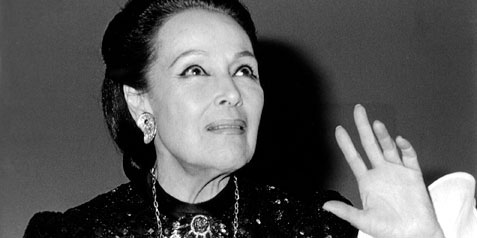Year: 1981
She went from Hollywood sex symbol to become a major presence in Mexican cinema. At the age of 76 Dolores Del Rio appeared on the stage of the Palace of Fine Arts theater the evening of October 11, 1981 for an unforgettable tribute at the 25th San Francisco International Film Festival.
Photo: Dolores Del Rio, the subject of a tribute at the 24th San Francisco International Film Festival. Photo by Pamela Gentile.
GREAT MOMENTS
DOLORES DEL RIO CHARMED AUDIENCES FOR OVER 50 YEARS

By Miguel Pendás
Her career spanned the silent and sound eras. She went from Hollywood sex symbol to become a major presence in Mexican cinema. (Isn’t it supposed to be the other way around?) Her consummate grace, elegance and wit never left her. At the age of 76 Dolores Del Rio appeared on the stage of the Palace of Fine Arts theater the evening of October 11, 1981 for an unforgettable tribute at the 25th San Francisco International Film Festival.
The dominant feeling at the event seemed to be amazement at how her physical beauty had survived. The silent screen star of What Price Glory?, the nimble dancer of Flying Down to Rio (in which neophytes Fred Astaire and Ginger Rogers had second billing) was still slender and beautiful. "Beauty comes from inside, not out of a bottle," was her explanation. And health. She didn’t drink, smoke or follow diets.
The audience was treated to two hours of clips from her American films before she made her appearance. A scene from the 1932 Bird of Paradise had her in a skimpy sarong, sucking the juice out of a tropical fruit and transferring it to the mouth of a passed-out Joel McCrea to revive him. "You certainly make civilization look silly," was his response, and the Festival audience agreed heartily.
Her career began in 1925 with the silent Joanna, and by the 1930s she was living the life of Hollywood aristocracy with friends like Orson Welles, Marion Davies, Jack Warner and Charlie Chaplin. In 1941, after her marriage to art director extraordinaire Cedric Gibbons ended, she decided she had had enough of Hollywood typecasting and bolted for Mexico City, settling down in the bohemian enclave of Coyoacan, with Diego Rivera and Frida Kahlo for neighbors. "I got tired of being a star. I wanted to be an actress, and I found it difficult to reveal myself as a serious actress when I was buried under thousands of feathers," she explained, in a reference to the Busby Berkeley–mandated costumes she wore in musicals like Wonder Bar and In Caliente.
In Mexico she enjoyed a career as a leading dramatic actresses in that country’s golden age of cinema, starring in such classics as Maria Candelaria and Flor Silvestre, both directed by Emilio Fernández. She also appeared in The Fugitive, directed by John Ford, which was filmed largely in Mexico. "The John Ford experience was unique," she said. "I feel very reverent about it"
Later in her career she came back to the U.S. to make a few pictures, including Flaming Star (Don Siegel, 1960) with Elvis Presley ("The most courteous actor I ever worked with") and a brief appearance for old times’ sake in Ford’s Cheyenne Autumn (1964). In 1967 she appeared in Francesco Rosi’s More Than a Miracle, which was added to the Festival program in 1981 as a very appropriate last-minute substitution. The great Italian director was at the Festival too, for the screening of his then most recent film, Three Brothers.
